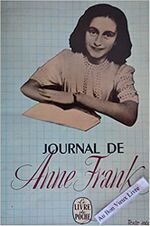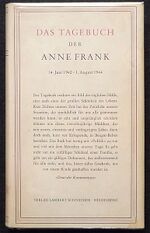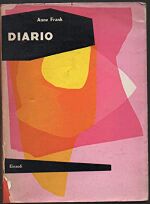File:1947 Frank.jpg
1947_Frank.jpg (250 × 383 pixels, file size: 49 KB, MIME type: image/jpeg)
Anne Frank. Het achterhuis: dagboekbrieven van 12 Juni 1942-1 Augustus 1944. Amsterdam : Contact, 1947. <Dutch>
Translations
- French ed. (1950) : Le journal d'Anne Frank, tr. T. Caren et Suzanne Lombard. Paris [France]: Calmann-Lévy, 1950.
- German ed. (1950) : Das Tagebuch der Anne Frank, tr. Anneliese Schütz. Heidelberg [Germany]: L. Schneider, 1950.
- English ed. (1952) : The Diary of a Young Girl
- Spanish ed. (1952) : Diario de Ana Frank. Montevideo [Uruguay], Condor, 1952.
- Italian ed. (1954) : Il diario di Anne Frank, tr. Arrigo Vita. Milano CDE, 1954.
- Published in more than 70 languages.
Adaptation
Adapted several times to the stage and to the screen.
Abstract
The Diary of Anne Frank is by far the most famous among the children's diaries of the Holocaust and one of the world's best known books of the twentieth century. It was written by Holocaust victim Anne Frank (1929-1945) in 1942-44 (age 13-15), while Anne and her family were in hiding in Amsterdam.
Anne's father, Otto was the only survivor of the Franks. He returned to Amsterdam after the war to find that Anne's diary had been saved by his secretary, Miep Gies, and his efforts led to its publication in 1947. It was translated from its original Dutch version and first published in English in 1952 as The Diary of a Young Girl, and has since been translated into over 70 languages.
"Discovered in the attic in which she spent the last years of her life, Anne Frank’s remarkable diary has become a world classic—a powerful reminder of the horrors of war and an eloquent testament to the human spirit ... In 1942, with the Nazis occupying Holland, a thirteen-year-old Jewish girl and her family fled their home in Amsterdam and went into hiding. For the next two years, until their whereabouts were betrayed to the Gestapo, the Franks and another family lived cloistered in the “Secret Annexe” of an old office building. Cut off from the outside world, they faced hunger, boredom, the constant cruelties of living in confined quarters, and the ever-present threat of discovery and death. In her diary Anne Frank recorded vivid impressions of her experiences during this period. By turns thoughtful, moving, and surprisingly humorous, her account offers a fascinating commentary on human courage and frailty and a compelling self-portrait of a sensitive and spirited young woman whose promise was tragically cut short."
File history
Click on a date/time to view the file as it appeared at that time.
| Date/Time | Thumbnail | Dimensions | User | Comment | |
|---|---|---|---|---|---|
| current | 11:53, 7 January 2020 |  | 250 × 383 (49 KB) | Gabriele Boccaccini (talk | contribs) |
You cannot overwrite this file.
File usage
The following 6 pages use this file:




